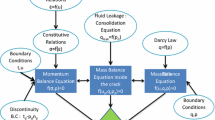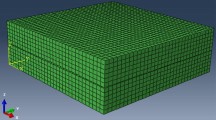Abstract
Analytical models are presented to provide enhanced capabilities for modeling fluid flow through natural fractures nested in parallel plate type configurations. The modeled fractures may be arbitrarily positioned, but subgrouped according to the consistent parallel sequences. The derived analytical expressions for fracture permeability can be considered as an extension to those in which flow within fractures is uniform and isotropic. This modification offers a correction for the traditional permeability calculations whenever fractures are oblique to the flow orientation. For the fracture flow scenarios, the graphical solutions show the permeability envelope normal to any arbitrary planes within the calculated domain. Consideration of rock anisotropy may significantly improve the accuracy in determining the formation permeability in cases where natural fractures exhibit a dominant control in regional fluid flow.
Similar content being viewed by others
REFERENCES
Bear, J., 1972, Dynamics of fluids in porous media: Elsevier, New York, 764 p.
Eringen, A. C., 1967, Mechanics of continua: John Wiley & Sons, Inc., New York.
Hsieh, P. A., and Neuman, S. P., 1985, Field determination of the three-dimensional hydraulic conductivity tensor of anisotropic media, 1. Theory: Water Resources Res., v. 21, no. 11, p. 1655–1665.
Hsieh, P. A., Neuman, S. P., Stiles, G. K., and Simpson, E. S., 1985,Field determination of the threedimensional hydraulic conductivity tensor of anisotropic media, 2. Methodology and application to fractured rocks: Water Resources Res., v. 21, no. 11, p. 1667–1676.
Lamb, H., 1932, Hydrodynamics (6th Ed.): Cambridge University Press, New York.
Muskat, M., 1937, The flow of homogeneous fluids through porous media: McGraw-Hill, New York.
Oda, A., 1985, Permeability tensor for discontinuous rock masses: Geotechnique, v. 35, no. 4, p. 483–495.
Sagar, B., and Runchal, A., 1982, Permeability of fracture rock: effect of fracture size and data uncertainties: Water Resources Res., v. 18, no. 2, p. 266–274.
Schlichting, H., 1968, Boundary layer theory (6th Ed.): McGraw-Hill, New York.
Snow, D. T., 1968, Rock fracture spacings, openings, and porosities: J. Soil Mech. and Found. Div., Proc. ASCE, v. 94, p. 73–91.
Snow, D. T., 1969, Anisotropic permeability of fractured media: Water Resources Res., v. 5, no. 6, p. 1273–1289.
Vaziri, H. H., and Byrne, P. M., 1990, Analysis of stress, flow, and stability around deep wells: Geotechnique, v. 40, p. 63–77.
Wang, J. S. Y., 1991, Flow and transport in fractured rocks: Reviews of Geophysics (Suppl.), p. 254–262.
Witherspoon, P. A., Wang, J. S. Y., Imai, K., and Gale, J. E., 1980, Validity of cubic law for fluid flow in a deformable rock fracture: Water Resources Res., v. 16, p. 1016–1024.
Author information
Authors and Affiliations
Rights and permissions
About this article
Cite this article
Chen, M., Bai, M. & Roegiers, JC. Permeability Tensors of Anisotropic Fracture Networks. Mathematical Geology 31, 335–373 (1999). https://doi.org/10.1023/A:1007534523363
Issue Date:
DOI: https://doi.org/10.1023/A:1007534523363




